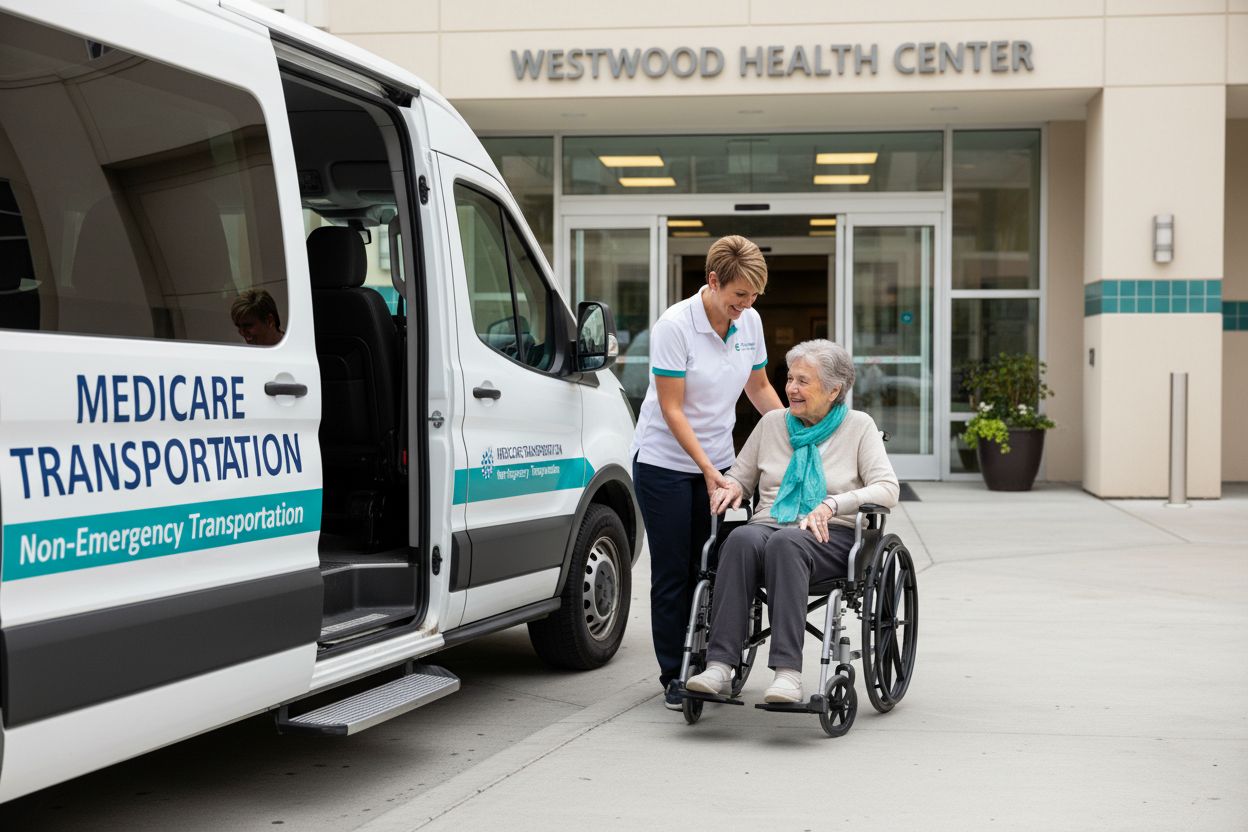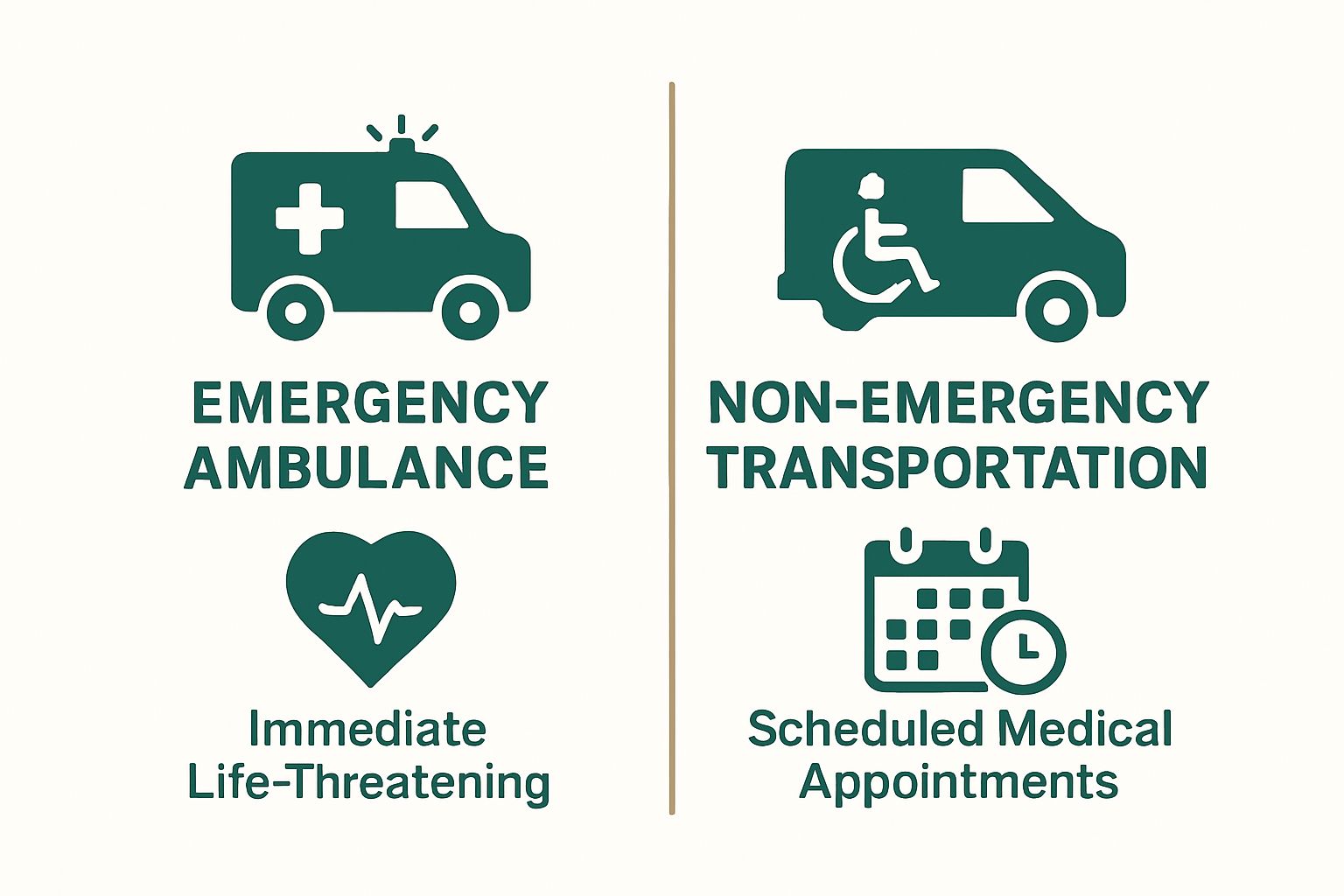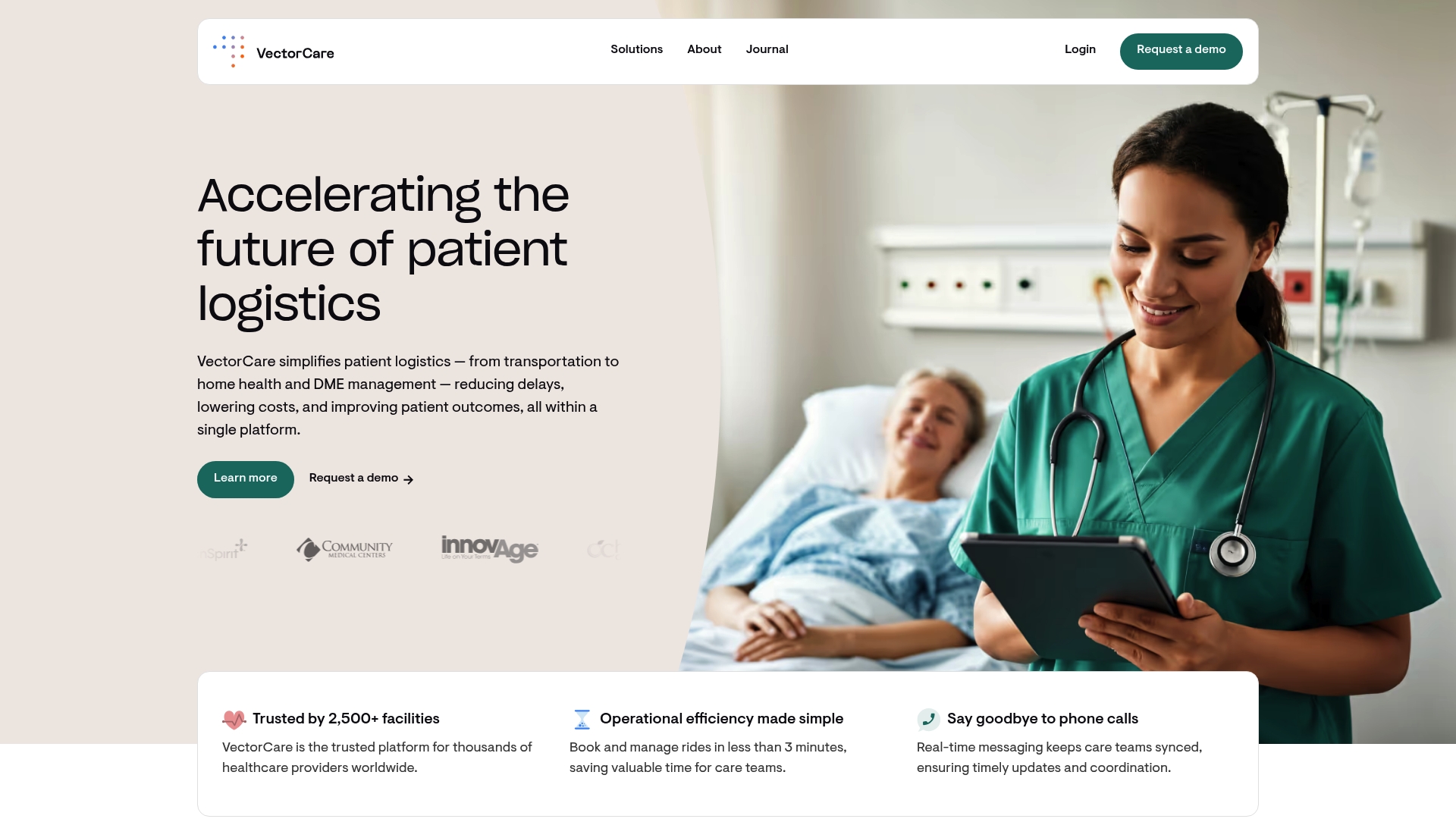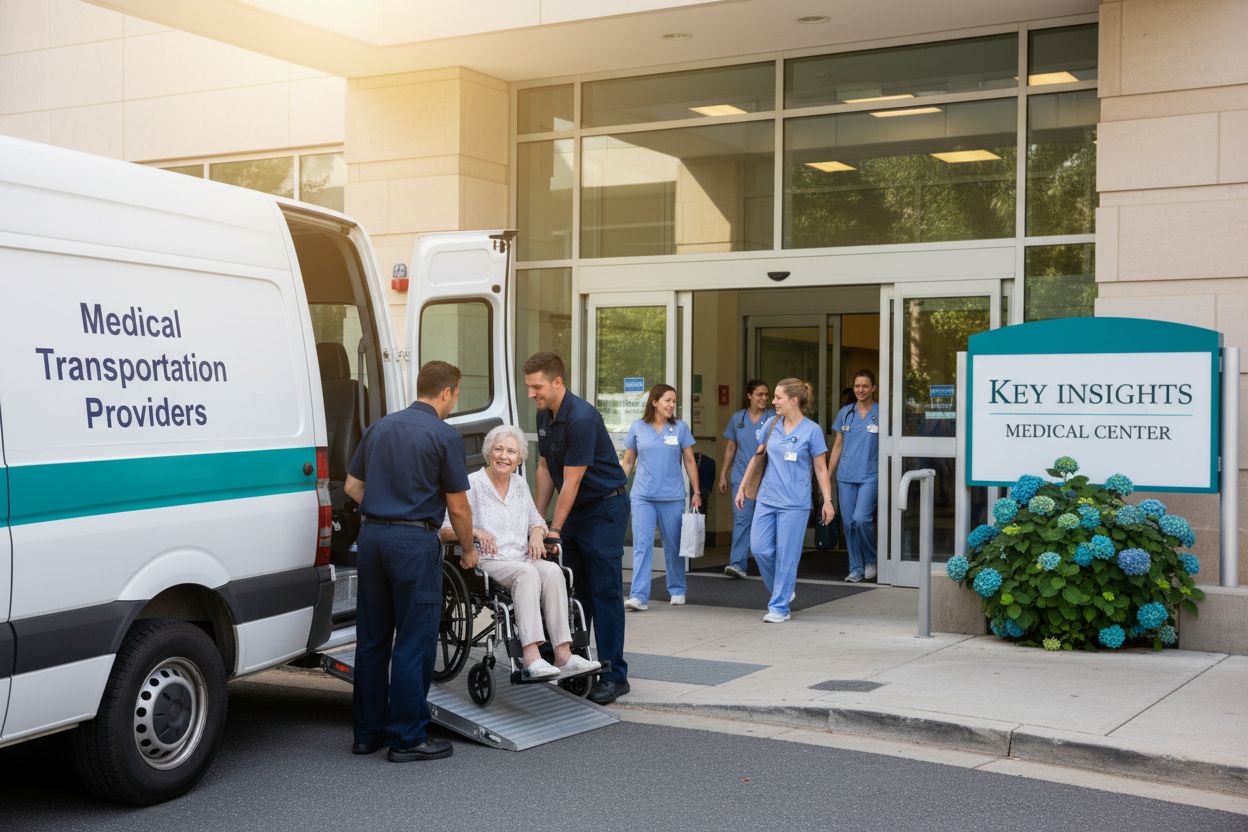Understanding Medicare Non-Emergency Transportation

Medicare non-emergency transportation sounds simple. Show up, get a ride, make it to your appointment. Yet, patients without reliable rides are much more likely to end up in the emergency room or miss critical treatments. Most people think this kind of help is easy to get with Medicare and only for emergencies. The real surprise is that strict medical necessity rules and detailed documentation keep non-emergency transportation out of reach for many, making it one of the most misunderstood lifelines in healthcare.
Table of Contents
- Defining Medicare Non-Emergency Transportation: Key Concepts
- The Importance of Non-Emergency Transportation in Healthcare
- How Medicare Non-Emergency Transportation Works
- Challenges and Considerations in Non-Emergency Transport Services
Quick Summary
| Takeaway | Explanation |
|---|---|
| Medicare covers necessary transport only. | Coverage is based on medical necessity, requiring documentation of health risks associated with standard transport. |
| Eligibility is defined by specified conditions. | Patients must experience mobility challenges or medical conditions to qualify for non-emergency transportation services. |
| Proper documentation is crucial for approval. | Healthcare providers must certify the need for non-emergency transportation to secure Medicare reimbursement. |
| Non-emergency transport addresses healthcare disparities. | This service plays an essential role in improving access to care for vulnerable populations. |
| Operational and financial challenges exist. | Providers face issues such as complex scheduling and variable reimbursement rates that impact service delivery. |
Defining Medicare Non-Emergency Transportation: Key Concepts
Medicare non-emergency transportation represents a critical healthcare service designed to support patients who require medical transit but do not face immediate life-threatening conditions. Unlike emergency ambulance services, these transportation options focus on ensuring patients can safely access necessary medical appointments, treatments, and healthcare facilities.

What Constitutes Non-Emergency Medical Transportation?
Non-emergency medical transportation encompasses specialized transport services for patients who cannot independently travel due to medical limitations. Understanding the nuances of non-emergency medical assistance helps patients and healthcare providers recognize when such services become essential. Key characteristics include:
- Transportation for scheduled medical appointments
- Transit for patients with mobility challenges
- Rides to rehabilitation centers or specialized treatment facilities
- Scheduled transfers between healthcare institutions
Patients qualifying for Medicare non-emergency transportation typically demonstrate specific medical requirements that prevent them from using standard transportation methods. These might include physical disabilities, chronic health conditions, or recovery limitations that make independent travel unsafe or impractical.
Eligibility and Coverage Parameters
Medicare coverage for non-emergency transportation is not universal and depends on several critical factors. According to Medicare guidelines, patients must demonstrate medical necessity. This means standard transportation methods could potentially compromise their health or medical stability.
Typical scenarios where Medicare might cover non-emergency transportation include:
- Required trips to receive critical medical treatments
- Transportation to dialysis appointments
- Transfers between skilled nursing facilities
- Medical visits essential for ongoing care management
Patients must obtain proper documentation from healthcare providers verifying the medical need for specialized transportation. Documentation typically includes physician certifications explaining why standard transportation poses health risks.
Understanding these transportation services requires recognizing they are not convenience services but medically prescribed transit solutions designed to support patient health and accessibility. By providing structured, safe transportation options, Medicare helps ensure patients can consistently receive necessary medical care regardless of individual mobility challenges.
To clarify the specific requirements for Medicare non-emergency transportation coverage, the table below outlines the medical necessity and documentation criteria that must be met by patients and providers.
| Requirement | Description |
|---|---|
| Inability to use standard transportation | Patient cannot use regular vehicles without risking health or safety |
| Medical equipment needed during transit | Patient requires medical devices or monitoring that standard transport cannot safely accommodate |
| Physical or medical condition limitations | Health condition or disability prevents safe independent travel |
| Physician certification required | Healthcare provider must document and certify the medical need |
| Detailed justification in documentation | Clear explanation of why standard transport poses risks is needed for Medicare approval |
| Trip is for essential medical care | Transport must be for appointments or treatments critical to ongoing health management |
The Importance of Non-Emergency Transportation in Healthcare
Non-emergency medical transportation plays a pivotal role in addressing healthcare accessibility challenges, particularly for vulnerable patient populations. Understanding what is non-emergency patient transport reveals the critical connection between transportation services and comprehensive patient care.
Healthcare Access and Patient Outcomes
According to research from the National Institutes of Health, transportation barriers significantly impact patients’ ability to receive timely and consistent medical care. Patients without reliable transportation are more likely to experience:
- Delayed medical treatments
- Increased health complications
- Higher rates of emergency room visits
- Reduced preventive care engagement
These transportation challenges disproportionately affect elderly patients, individuals with chronic conditions, and those with limited mobility. By providing structured medical transportation, healthcare systems can mitigate these significant barriers to consistent medical care.
Economic and Healthcare System Impact
Non-emergency medical transportation represents more than a convenience service. It is a critical infrastructure component that helps reduce overall healthcare system strain. Effective transportation services can:
- Decrease unnecessary emergency room admissions
- Reduce healthcare costs associated with untreated medical conditions
- Improve patient medication adherence
- Support chronic disease management strategies
Healthcare providers recognize that transportation is not just about moving patients from one location to another. It is about ensuring continuous, uninterrupted access to medical care, particularly for populations most vulnerable to healthcare disparities.
By addressing transportation barriers, healthcare systems can create more inclusive, patient-centered approaches that prioritize accessibility, preventive care, and comprehensive health management. Non-emergency medical transportation emerges as a fundamental strategy for improving patient outcomes and reducing systemic healthcare inequities.

How Medicare Non-Emergency Transportation Works
Medicare non-emergency transportation operates through a structured system designed to ensure patients receive medically necessary transit while maintaining strict eligibility and documentation requirements. Learn more about Medicare Advantage’s approach to non-emergency medical transportation to understand the comprehensive framework behind these critical services.
Medical Necessity and Documentation
According to Medicare guidelines, non-emergency transportation coverage hinges on demonstrating clear medical necessity. Patients must meet specific criteria to qualify, which includes:
- Inability to use other transportation methods without risking health
- Requirement for medical equipment during transit
- Physical or medical conditions preventing independent travel
- Documented physician certification of transportation needs
Healthcare providers play a crucial role in this process by completing detailed documentation that explicitly explains why standard transportation would compromise patient health. The documentation must provide specific medical justification for specialized transport services.
Coverage and Reimbursement Process
Medicare typically covers non-emergency transportation under specific circumstances. The reimbursement process involves multiple verification steps:
- Initial medical assessment by healthcare provider
- Completion of transportation necessity documentation
- Submission of claims to Medicare or Medicare Advantage plans
- Verification of patient’s medical eligibility
- Approval and coordination with approved transportation providers
Patients are generally responsible for understanding their specific Medicare plan’s transportation coverage. While Original Medicare Part B might cover some non-emergency ambulance services, Medicare Advantage plans often provide more comprehensive transportation benefits.
The intricate process ensures that non-emergency medical transportation remains a targeted service addressing genuine medical mobility challenges. By maintaining rigorous standards, Medicare helps prevent unnecessary healthcare expenses while supporting patients who cannot independently access medical care.
Challenges and Considerations in Non-Emergency Transport Services
Non-emergency medical transportation presents a complex landscape of operational, financial, and logistical challenges that require sophisticated solutions. Explore strategies for launching non-emergency medical transportation services to understand the intricate dynamics of this critical healthcare infrastructure.
Operational and Logistical Complexities
According to research from healthcare logistics experts, non-emergency transportation services face significant coordination challenges. Key operational obstacles include:
- Complex scheduling across diverse patient needs
- Coordinating between multiple healthcare providers
- Managing diverse medical equipment requirements
- Ensuring consistent service quality and reliability
Transportation providers must develop robust systems that can adapt to individual patient requirements while maintaining efficiency. This involves intricate routing algorithms, real-time communication protocols, and comprehensive patient health assessment mechanisms.
Financial and Regulatory Considerations
The financial landscape of non-emergency medical transportation is equally complex. Critical financial challenges encompass:
- Variable reimbursement rates from different Medicare plans
- High operational costs for specialized medical transport
- Compliance with strict regulatory requirements
- Managing insurance verification and claims processing
Healthcare organizations and transportation providers must navigate a multilayered financial ecosystem that demands precision, documentation, and continuous adaptation to changing regulatory frameworks.
The following table summarizes key operational and financial challenges faced by providers delivering Medicare non-emergency transportation services.
| Challenge Category | Example Issues | Impact on Service Delivery |
|---|---|---|
| Operational | Complex scheduling, multi-provider coordination | Delays, increased administrative burden |
| Logistical | Managing patient needs, medical equipment requirements | Risk of service inconsistencies |
| Financial | Variable reimbursement rates, high costs, claims management | Unpredictable revenue, sustainability concerns |
| Regulatory | Compliance with Medicare rules and documentation standards | Extra time spent on verification and paperwork |
Ultimately, successful non-emergency medical transportation services require a holistic approach that balances patient care, operational efficiency, and financial sustainability. By addressing these multifaceted challenges, providers can create a more responsive and patient-centered transportation infrastructure that supports comprehensive healthcare access.
Unlock Seamless Medicare Non-Emergency Transportation with VectorCare
Navigating Medicare non-emergency transportation can often feel overwhelming. Many healthcare teams struggle with complex scheduling, strict documentation requirements, and persistent coordination barriers that delay care. As you saw in this article, these operational and financial obstacles risk patient safety and increase costs, making consistent access to medical appointments a daily challenge.

Ready to move beyond these barriers? Discover how VectorCare’s advanced patient logistics platform automates and streamlines the entire non-emergency transportation process. With tools for real-time scheduling optimization, secure communication, and automated dispatching, your organization can reduce delays, simplify compliance, and deliver reliable care. Visit VectorCare now to see how technology can transform your Medicare transportation services and start improving outcomes for patients who need you most.
Frequently Asked Questions
What qualifies as Medicare non-emergency transportation?
Medicare non-emergency transportation is designed for patients who need transport to medical appointments but do not have life-threatening conditions. This includes rides for scheduled visits, rehabilitation, or inter-facility transfers for patients with mobility challenges.
How can I determine if I’m eligible for Medicare non-emergency transportation?
To qualify for Medicare non-emergency transportation, you must demonstrate medical necessity and that standard transportation methods could jeopardize your health. Obtain documentation from your healthcare provider that outlines your specific transportation needs to proceed with eligibility verification.
What steps should I follow to request non-emergency transportation through Medicare?
To request non-emergency transportation, you should first consult with your healthcare provider to assess your medical needs. Then, have your provider complete the required documentation certifying the need for specialized transport before submitting a claim to Medicare for coverage.
What types of documentation are needed to support a request for non-emergency transportation?
You’ll need a physician’s certification that specifies your medical need for non-emergency transportation. Ensure that this documentation clearly outlines why standard transportation is unsafe for you, facilitating a smoother approval process with Medicare.
How does medicare decide on reimbursement for non-emergency transportation services?
Medicare analyzes claims based on established medical necessity and documentation provided by your healthcare provider. To improve chances of reimbursement, ensure your claims include thorough medical justification, ideally submitted within 30 days of your transportation service.
What challenges might I face when using Medicare non-emergency transportation?
Common challenges include navigating the complex scheduling process and ensuring all necessary documentation is submitted accurately. Prepare by keeping organized records and coordinating closely with your healthcare provider to address any potential issues before they arise.



